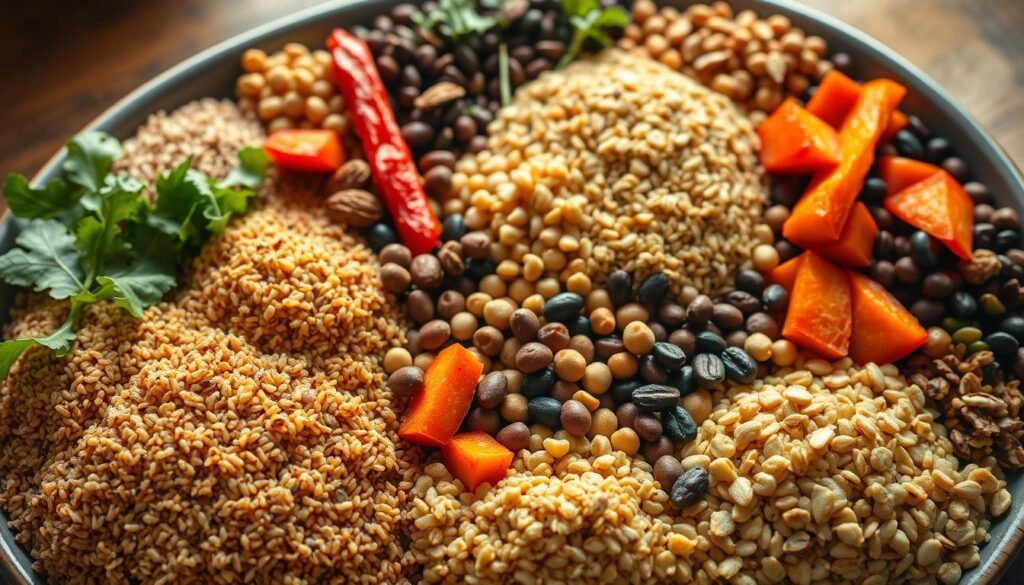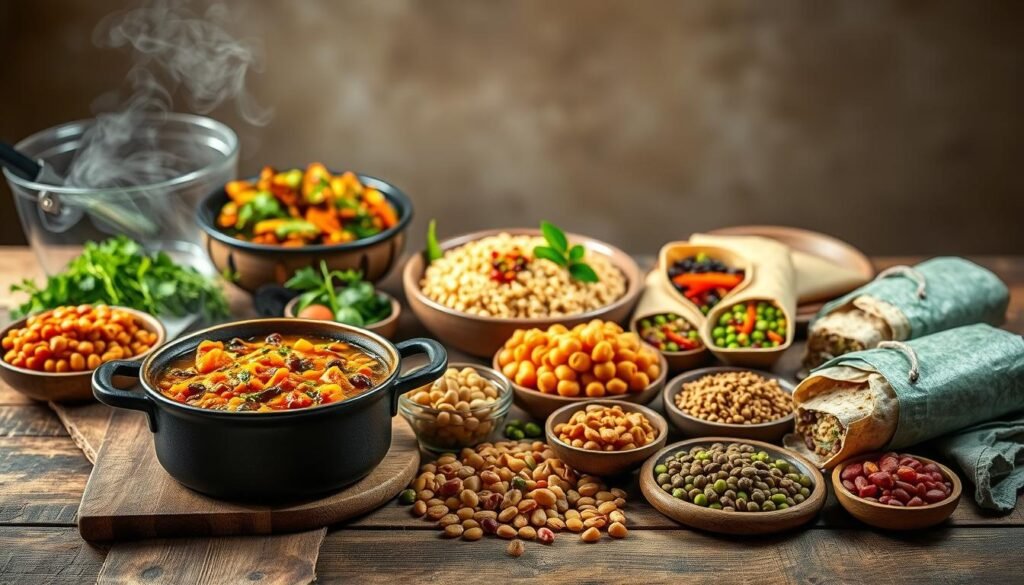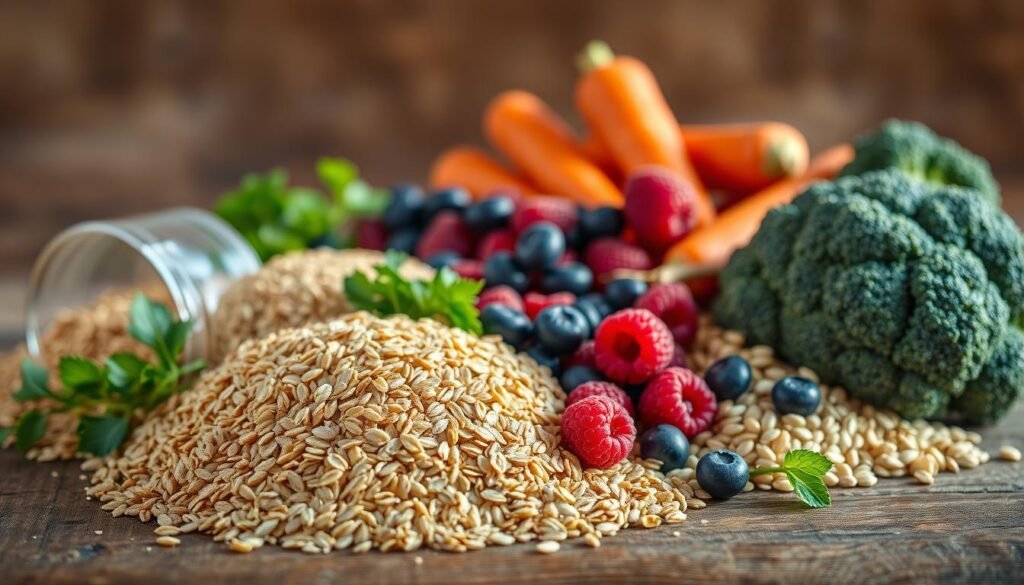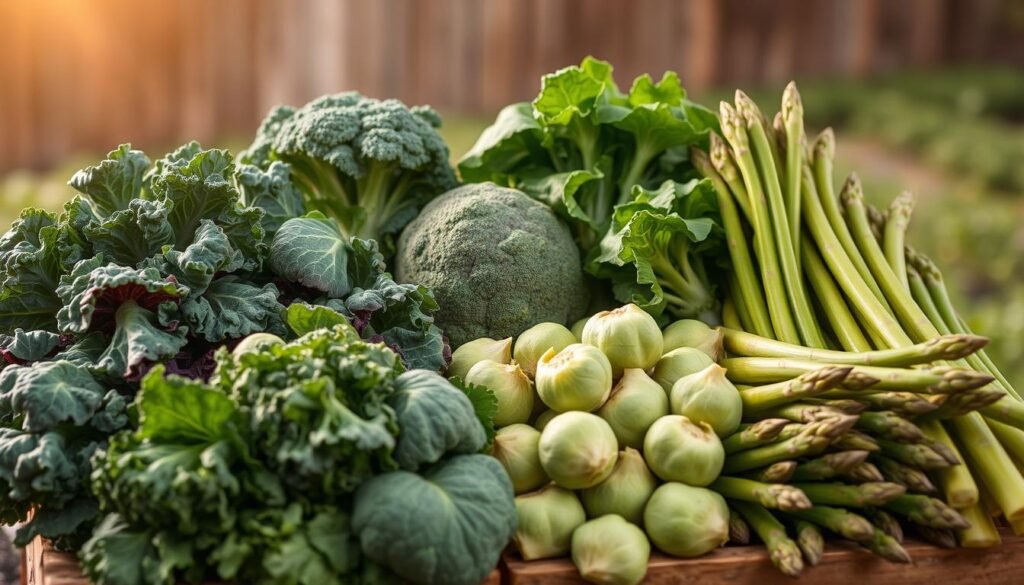Want to boost your fiber intake without losing flavor? You’re in the right spot. Adding more plant-based foods to your meals doesn’t mean they have to be boring. With the right recipes, you can make tasty dishes that keep you full and your gut happy.
Looking for something for breakfast, lunch, or dinner? This list has you covered. Imagine creamy avocado toast with a twist, or hearty grain bowls loaded with veggies. Even desserts can be a nutrient boost. These recipes are easy to follow and use common ingredients.
Why is fiber important? Most Americans only get half the fiber they need. This can cause slow digestion, energy drops, and cravings. By choosing whole foods like beans, oats, and fresh veggies, you’ll meet your fiber goals and enjoy satisfying meals.
Key Takeaways
- Discover breakfast, lunch, and dinner options that make increasing fiber simple
- Learn how to use affordable, easy-to-find ingredients for maximum nutrition
- Explore creative twists on classics, like upgraded avocado toast or lentil-stuffed peppers
- Understand why fiber matters for energy levels and long-term health
- Get inspired to meal prep with recipes that stay fresh for days
What Is Fiber and Why Is It Important?
Fiber is a key part of a healthy diet. It helps keep your digestive system working well. It also protects against chronic diseases. Let’s explore why fiber is so important.
The Role of Dietary Fiber
Fiber has two types: soluble and insoluble. Soluble fiber forms a gel that lowers cholesterol and stabilizes blood sugar. You can find it in oats, beans, and apples.
Insoluble fiber adds bulk to stool, preventing constipation. Think whole grains, nuts, and vegetables like carrots. These fibers work together like a broom for your intestines.
They feed good gut bacteria, reduce inflammation, and help absorb nutrients better. Studies show a 30% lower heart disease risk for those with high-fiber diets.
Benefits of a Fiber-Rich Diet
A fiber-rich diet plan does more than just keep you regular. It helps you:
- Maintain a healthy weight by keeping you full longer
- Reduce diabetes risk by slowing sugar absorption
- Lower blood pressure through improved gut health
The best sources of dietary fiber offer both types. Lentils, chia seeds, and berries are great options. They provide 5-10 grams of fiber per serving.
Recommended Daily Fiber Intake
Most Americans don’t get enough fiber. Experts recommend:
| Age Group | Men | Women |
|---|---|---|
| 19-50 years | 38g | 25g |
| 51+ years | 30g | 21g |
| Pregnant Women | 28g | |
If you’re new to high-fiber foods, start slow. Increase your intake by 5g daily to avoid bloating. Drink plenty of water with fiber-rich foods for the best results.
Easy Breakfast Options to Boost Fiber
Starting your day with fiber-rich meals is easy and quick. These three breakfast ideas are packed with nutrients and are easy to make. Each recipe has at least 8 grams of fiber, which is a third of what you need all day.
Overnight Oats with Chia Seeds
Start by mixing rolled oats, chia seeds, and almond milk in a jar before bed. By morning, you’ll have a creamy breakfast with 15 grams of fiber. Add raspberries and sliced almonds for extra flavor and crunch.
Chia seeds soak up liquid and help with digestion. Choose steel-cut oats for more fiber than instant oats.
Avocado Toast on Whole Grain Bread
Spread half an avocado on toasted Ezekiel bread (4g fiber per slice). Add red pepper flakes and lemon juice for taste. This quick fiber-rich recipe has 12g of fiber, as much as three apples!
Whole grain breads have more nutrients than white bread. Look for “100% whole grain” labels and at least 3g fiber per slice.
Smoothie with Spinach and Banana
Blend frozen banana, spinach, Greek yogurt, and flaxseeds for a fiber-rich smoothie. The banana makes it sweet, and spinach adds 4g fiber per two cups. Add peanut butter for extra energy.
Spinach is a great source of fiber, even more than many fruits. Use frozen spinach to save money and reduce waste. For a thicker smoothie, add half an avocado instead of ice.
Filling Fiber-Packed Lunches
Feeling tired after lunch? These meals mix fiber-rich food suggestions with protein. They keep you full and focused, avoiding the afternoon slump. Let’s explore three delicious fiber-rich dishes that are simple to make and full of nutrients.
Quinoa Salad with Black Beans and Veggies
This salad is a protein powerhouse. It combines cooked quinoa, black beans, cherry tomatoes, and bell peppers. Add lime juice, olive oil, and cilantro for a zesty taste. Pro tip: Include avocado slices for healthy fats that enhance nutrient absorption.
Lentil Soup with Whole Grain Bread
Warm lentil soup is packed with 15 grams of fiber per serving. It’s made with red lentils, carrots, celery, and cumin. Serve it with whole grain bread for a satisfying meal. The mix of legumes and whole grains helps control blood sugar and reduces cravings.
Chickpea Salad Sandwich
Make a creamy spread by mashing chickpeas with avocado instead of mayo. Layer it on whole grain bread with spinach, cucumber, and carrots. Boost the crunch with sunflower seeds or flaxseeds. This sandwich has up to 12 grams of fiber per serving!
Ready to improve your lunch routine? These meals show that delicious fiber-rich dishes are easy to make. Use whole ingredients, and you’ll stay energized all afternoon.
Hearty Dinner Ideas That Are Fiber-Rich

Dinner is a great time to add fiber to your meals. These easy high fiber meals are both tasty and nutritious. They use whole grains, legumes, and veggies to keep you full.
Whole Wheat Pasta with Broccoli and Garlic
Choose whole wheat pasta to get more fiber. Mix it with roasted broccoli and garlic in olive oil. Broccoli is best when it’s a bit crunchy.
Add Parmesan or nutritional yeast for extra taste.
Stuffed Bell Peppers with Brown Rice
Use bell peppers as bowls for a filling of brown rice, black beans, and tomatoes. Bake at 375°F for 25 minutes. Brown rice and beans are high in fiber.
Smoked paprika adds a nice flavor to the filling.
Vegetable Stir-Fry with Tofu
Stir-fry snap peas, carrots, and bok choy with tofu. Use tamari or coconut aminos for flavor. Serve over quinoa for more fiber and protein.
These fiber-rich meal ideas make dinner both healthy and delicious. Cooking methods like steaming and roasting help keep veggies’ fiber. Drink water or herbal tea with meals to help digest and absorb nutrients.
Delicious Snacks to Enhance Your Fiber Intake
Boost your daily fiber intake with these tasty snack ideas. Smart snacking keeps your energy up and aids digestion. Choose whole foods like veggies, whole grains, and seeds for fiber-rich bites.
Hummus with Raw Vegetables
Enjoy creamy hummus with crunchy veggies like carrots, bell peppers, or celery. Chickpeas in hummus add 4 grams of fiber per ¼ cup. Add raw veggies for extra crunch and nutrients. Use whole-grain pita chips for a heartier snack.
Popcorn Seasoned with Nutritional Yeast
Air-popped popcorn has 3.5 grams of fiber per 3-cup serving. Skip the butter and add nutritional yeast for a cheesy taste and B-vitamin boost. This snack is low in calories but filling, great for mindful eating.
Trail Mix with Nuts and Seeds
Make a balanced trail mix with almonds, walnuts, pumpkin seeds, and dried fruit. Add flaxseeds for omega-3s and extra fiber. Choose unsweetened options to avoid added sugars. A ¼-cup serving has about 4 grams of fiber and healthy fats.
| Snack | Fiber per Serving | Key Ingredients | Prep Time |
|---|---|---|---|
| Hummus & Veggies | 6g | Chickpeas, carrots, celery | 5 mins |
| Popcorn | 3.5g | Air-popped corn, nutritional yeast | 3 mins |
| Trail Mix | 4g | Almonds, flaxseeds, dried fruit | 2 mins |
For more fiber-rich snack ideas, check out recipes that are both convenient and nutritious. These snacks show that healthy fiber meals can be part of your daily routine, not just main dishes.
Creative Ways to Incorporate Legumes
Legumes don’t have to be boring. Discover delicious ways to enjoy them and get more fiber. Beans, lentils, and chickpeas are affordable and full of nutrients. They support a fiber-rich diet plan.
Whether you’re cooking for Meatless Monday or just want to mix up your meals, these recipes make legumes into tasty dishes.

Soaking dried legumes overnight makes them cook faster and easier to digest. This helps you get more fiber. For quick ideas, check out these 12 delicious ways to eat more beans.
Bean Chili Loaded with Vegetables
Three-bean chili has 15 grams of fiber per bowl. Mix kidney beans, black beans, and pinto beans with tomatoes, bell peppers, and zucchini. Add smoked paprika and cumin for flavor. Top with avocado for creaminess.
- Use low-sodium broth to control salt levels
- Add corn for sweetness and texture
- Top with Greek yogurt instead of sour cream
Falafel Wrap with Tzatziki Sauce
Crispy baked falafel from chickpeas is great in a whole-grain wrap. Add crunchy veggies and tzatziki sauce for a tangy taste. One wrap has 10 grams of fiber.
- Use pre-cooked chickpeas to save time
- Add shredded cabbage for extra crunch
- Drizzle with lemon juice before serving
Lentil Curry with Brown Rice
Red lentils cook fast and make a creamy curry. Simmer them with coconut milk, turmeric, and ginger. Serve over brown rice for a 20-gram fiber meal.
- Stir in spinach during the last 5 minutes
- Toast spices first for deeper flavor
- Freeze leftovers for easy reheating
Fiber-Rich Smoothie Recipes
Making fiber-packed smoothies is a quick way to get your daily nutrients. These quick fiber-rich recipes are both tasty and fast, taking less than 5 minutes to prepare. They’re perfect for busy mornings or post-workout snacks, turning frozen fruits and smart add-ins into delicious fiber-rich dishes you’ll love.
Berry Spinach Smoothie with Flaxseeds
This vibrant purple-green blend hides spinach’s earthy taste behind sweet berries. Here’s how to make it:
- 1 cup frozen mixed berries
- 1 handful fresh spinach
- 1 tbsp ground flaxseeds
- ½ cup Greek yogurt
- ½ cup almond milk
Pro tip: Add 1 tsp psyllium husk for 5 extra grams of fiber – it dissolves completely!
Tropical Green Smoothie with Avocado
Creamy avocado pairs perfectly with tangy pineapple in this hydrating option:
- ½ ripe avocado
- 1 cup frozen mango chunks
- ½ cup coconut water
- 1 tbsp chia seeds
- 1 tsp lime juice
Blend until smooth, then sprinkle oat bran on top for crunch and added fiber.
Peanut Butter Banana Smoothie Bowl
Turn your drink into a spoonable meal with this thick, nutty recipe:
- 1 frozen banana
- 2 tbsp peanut butter
- ¼ cup rolled oats
- ¾ cup unsweetened almond milk
- Ice cubes (as needed)
Top with sliced almonds and a drizzle of honey. For extra fiber, mix in 1 tbsp acacia powder – it won’t change the texture!
Healthy Whole Grain Options

Whole grains are packed with fiber, vitamins, and minerals. They are better than refined grains because they keep their bran and germ. This makes them a top choice for fiber and energy. Here are three recipes that make these grains into tasty meals.
Oatmeal Variations for Breakfast
Oatmeal is a great start to your day. It has 4 grams of fiber. You can make it even better with these easy high fiber meals:
- Top with chia seeds (5g fiber per tablespoon) and sliced strawberries
- Mix in mashed raspberries (8g fiber per cup) and almond butter
- Stir roasted pumpkin (3g fiber per ½ cup) and cinnamon
Whole Grain Couscous Salad
Whole wheat couscous cooks fast, in just 5 minutes. It’s perfect for quick lunches. Here’s a fiber-rich salad:
- Combine cooked couscous (6g fiber per cup) with diced cucumbers
- Add roasted chickpeas (12g fiber per cup) and sun-dried tomatoes
- Toss with lemon-tahini dressing and fresh parsley
Barley Salad with Roasted Vegetables
Barley is chewy and has 6g fiber per cup. Try this hearty mix:
- Roast zucchini, bell peppers, and red onion
- Mix with cooked barley and crumbled feta
- Dress with olive oil and balsamic vinegar
| Grain | Fiber per Cup (Cooked) | Cooking Time | Best Uses |
|---|---|---|---|
| Steel-Cut Oats | 5g | 20 mins | Breakfast bowls |
| Whole Wheat Couscous | 6g | 5 mins | Salads, sides |
| Pearled Barley | 6g | 30 mins | Soups, grain bowls |
To keep nutrients in, rinse grains before cooking and don’t overcook. Pair these easy high fiber meals with lean proteins for balanced meals that keep you full.
Benefits of Adding Nuts and Seeds
Nuts and seeds are packed with nutrients and add a nice crunch. Almonds have 3.5 grams of fiber per ounce. Chia seeds offer 10 grams per ounce. They also have healthy fats and protein, making them great for snacks or recipes.
Nut Butter Toast with Fruit
Spread almond or peanut butter on whole-grain toast for a quick healthy fiber meal. Add sliced strawberries or bananas for extra vitamins and fiber. Use only 1-2 tablespoons of nut butter to keep it balanced. Choose brands without added sugars or oils for the best benefits.
Chia Pudding with Almond Milk
Mix chia seeds with unsweetened almond milk and let it sit overnight. The seeds soak up the liquid, making a fiber-rich pudding. Add blueberries or shredded coconut for flavor. This easy recipe is perfect for busy mornings.
Energy Bites with Rolled Oats
Blend rolled oats, sunflower seeds, and dates in a food processor. Roll into balls for a tasty snack. Each bite has 3-4 grams of fiber. Store them in the fridge for up to a week to curb cravings without processed sugars.
Pro tip: Eating nuts and seeds with water helps fiber move through your body. A small handful (about 1 oz) daily meets most dietary needs.
Exploring High-Fiber Vegetables
Vegetables are packed with fiber, adding crunch and flavor to our meals. Options like Brussels sprouts, kale, and sweet potatoes offer 4-6 grams of fiber per cooked cup. They make our meals exciting and nutritious.

Roasted Brussels Sprouts with Balsamic Glaze
Start by trimming and halving Brussels sprouts. Toss them in olive oil and roast at 425°F for 20 minutes. Finish with a drizzle of balsamic glaze for a sweet touch.
This method keeps 75% of their fiber content intact. For extra crispiness, spread sprouts evenly on the baking sheet.
Sautéed Kale with Garlic and Olive Oil
Begin by massaging raw kale leaves for 1 minute. This softens their texture. Then, sauté minced garlic in olive oil until fragrant.
Add kale and cook for 3-4 minutes. One cup of cooked kale gives you 5 grams of fiber. Add lemon juice to boost iron absorption.
Sweet Potato Fries with Skin
Slice sweet potatoes into wedges, keeping the skin on for double the fiber. Bake at 400°F for 25 minutes. The skin adds insoluble fiber for better digestion.
The flesh is rich in beta-carotene. Sprinkle with paprika or rosemary for a tasty twist without extra calories.
The Importance of Hydration with Fiber
Hydration is more than just drinking water. It’s key to a fiber-rich diet plan. Without enough fluids, fiber can’t work right. This part talks about how water and fiber team up for better digestion.
Water's Role in Digestion
Fiber absorbs water as it moves through your body. This makes stool softer and easier to pass. Without enough water, fiber can cause bloating or constipation instead.
Think of water as the lubricant for fiber. It helps move waste out of your body. Drink at least 8 cups of fluids daily when eating more fiber. Herbal teas or infused water count too!
Tips for Staying Hydrated
Having trouble drinking enough water? Try these tips:
- Use a hydration-tracking app like WaterMinder or MyFitnessPal
- Carry a reusable bottle with time markers
- Add flavor with lemon slices, mint, or cucumber
- Set hourly phone reminders during busy days
Drink water with every healthy fiber meal. For example, have a glass before oatmeal or lentil salad.
Fiber-Rich Foods That Are Also Hydrating
Some foods offer both fiber and hydration. Add these to your meals:
| Food | Fiber (per cup) | Water Content | Serving Ideas |
|---|---|---|---|
| Cucumbers | 0.5g | 96% | Salads, infused water |
| Oranges | 4.3g | 86% | Snacks, smoothies |
| Strawberries | 3g | 91% | Yogurt topping, desserts |
| Zucchini | 1.2g | 94% | Spiralized noodles, stir-fries |
These foods help meet hydration goals and boost fiber. Try adding sliced cucumbers to sandwiches or blending frozen strawberries into smoothies.
Common Myths About Fiber
Fiber is often misunderstood, leading to bad diet choices. Let’s clear up three common myths that might be stopping you from getting enough fiber.
Debunking Misconceptions
One big myth is that all fiber is created equal. Soluble and insoluble fiber both aid digestion but in different ways. Soluble fiber dissolves in water, found in foods like oats and apples. Insoluble fiber adds bulk, found in broccoli and whole grains.
Another myth is “supplements can replace whole foods.” While fiber pills or powders can help, they lack the nutrients found in whole foods. Studies show whole foods are better for gut health than supplements.
Understanding Soluble vs. Insoluble Fiber
Knowing the difference helps you choose the right foods. Here’s a quick guide:
| Type | Benefits | Sources |
|---|---|---|
| Soluble Fiber | Lowers cholesterol, stabilizes blood sugar | Beans, avocados, flaxseeds |
| Insoluble Fiber | Prevents constipation, supports bowel health | Whole wheat, carrots, almonds |
Most recipes include both types, like lentil curry with brown rice or a berry smoothie bowl with chia seeds.
The Truth About Fiber Supplements
Supplements aren’t bad, but they shouldn’t be your first choice. A 2022 study found people relying on supplements missed out on nutrients in whole foods. For example:
- Psyllium husk can ease constipation but lacks the protein in lentils.
- Prebiotic powders support gut bacteria but don’t provide the antioxidants in berries.
“Natural sources of fiber offer synergistic benefits that isolated supplements can’t replicate.”
Use supplements as a backup, not a replacement. Pair them with fiber-rich snacks like hummus and veggies for balanced nutrition.
Meal Prep Ideas for Fiber-Rich Diets
Getting more fiber doesn’t have to be hard. With good meal prep, you can save time and eat well. We’ll show you how to plan, store, and cook fiber-rich meals easily.
Planning Your Fiber-Focused Week
Begin by planning meals that mix soluble and insoluble fibers. For breakfast, try oatmeal with berries. Cook quinoa or lentils in bulk for many meals.
Pro tip: Make a “fiber checklist” to meet your daily goals. Include:
- 3+ servings of whole grains
- 2 cups of legumes weekly
- 5+ daily vegetable portions
Storage Tips for Fiber-Rich Foods
Keep foods fresh and full of nutrients with these tips:
| Food | Pantry | Fridge | Freezer |
|---|---|---|---|
| Quinoa | 6 months | 7 days (cooked) | 8 months |
| Lentils | 1 year | 5 days (cooked) | 10 months |
| Chickpeas | 2 years (dry) | 4 days (cooked) | 6 months |
Keep chopped veggies fresh in airtight containers with damp paper towels.
Easy Batch Cooking Recipes
Try these quick fiber-rich recipes that freeze well:
Lentil & Vegetable Stew:
- 2 cups dry lentils
- 4 cups mixed vegetables
- 6 cups vegetable broth
Cook for 25 minutes, then freeze in jars for 3 months.
Quinoa Power Bowls:
- 3 cups cooked quinoa
- Roasted sweet potatoes
- Steamed kale
- Chickpeas
Prepare each part separately for easy lunches.
Conclusion: Embrace Fiber in Your Diet
Adding fiber to your meals is easy. Try overnight oats, quinoa salads, or stuffed bell peppers. Start with one or two recipes and see how it goes.
Key Takeaways for Your Fiber Journey
Breakfast smoothies and lentil curries are great for fiber. Add snacks like hummus or trail mix to keep up. A fiber-rich diet needs water and whole foods too.
Make Fiber Work for You
Use chia seeds, black beans, or roasted veggies to spice up meals. Swap white rice for barley or use whole grain bread. Bob’s Red Mill and Eden Foods have great products for your pantry.
Your Next Steps
Get our free 7-day fiber tracker to track your progress. For more ideas, check out EatRight.org or MyFitnessPal. Small changes, like spinach in smoothies or popcorn instead of chips, help a lot.
A fiber-rich diet boosts digestion, energy, and health. Keep trying new things, stay consistent, and enjoy your meals.
FAQ
What are some easy high-fiber breakfast recipes?
Try overnight oats with chia seeds, avocado toast on Dave’s Killer Bread, or a spinach-banana smoothie with frozen berries. These recipes are easy and packed with 8–12 grams of fiber to start your day right.
How can I add more legumes to my fiber-rich diet plan?
Add lentils, chickpeas, or black beans to dishes like lentil curry with Lundberg brown rice, 3-bean chili with Bush’s Best beans, or falafel wraps using Bob’s Red Mill chickpea flour. Soaking legumes overnight helps your body absorb more fiber.
Are fiber supplements as effective as whole foods?
Supplements like Metamucil offer soluble fiber, but whole foods like raspberries (8g fiber/cup) and quinoa provide more nutrients. The USDA suggests eating whole foods for better health benefits.
What vegetables have the highest fiber content?
Artichokes (10g fiber each), roasted Brussels sprouts with skin (4g/cup), and sautéed kale (5g/cup) are great choices. Sweet potatoes with skin have 4g fiber per medium spud.
How do I meal prep fiber-rich dishes without spoilage?
Store cooked farro or barley in Glasslock containers for 5 days. Freeze lentil soup in Souper Cubes trays. Keep chopped veggies in water to stay crunchy.
Can high-fiber meals help with weight management?
Yes. Foods like chia pudding (10g fiber/3 tbsp seeds) and roasted edamame help you feel full. Studies show eating 25g+ of fiber daily can lead to weight loss.
What’s the best way to increase fiber without bloating?
Add 3–5g of fiber daily while drinking 64oz of water. Start with peeled apples or steamed broccoli before adding raw veggies. If you’re sensitive, try a FODMAP approach.
Are there fiber-rich snacks I can buy pre-made?
Yes! Kind Breakfast Bars (10g fiber), SkinnyPop Popcorn (3g/cup), and Saffron Road roasted chickpeas (5g/serving) are easy to grab. Always check labels for added sugars.
How does hydration impact a high-fiber diet?
Water helps soluble fiber form a gel that slows digestion. Drink 16oz of water with fiber-rich meals. Cucumber slices or watermelon cubes add hydration and fiber.
What whole grains offer the most fiber per serving?
Pearled barley (6g/cup), quinoa (5g/cup), and whole wheat pasta (6g/cup) are high in fiber. Replace white rice with Lundberg Farms black rice for more fiber.


Pingback: Safe Prenatal Workouts: A Trimester Guide